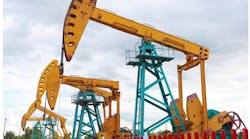Depending on the state they live in, many consumers are perplexed when they hear there is a slump in the oil industry. They pull up to the pumps to refuel their cars and are paying less than they have in at least a couple of years. But for companies that supply the oil industry and that support the equipment used in oil drilling, it is another story altogether.
Economist Donald Norman addressed the volatility and lack of oil price stability in an essay written for The Manufacturers Alliance for Productivity and Innovation (MAPI) recently. He wrote that in June of 2014, the price of crude was around $115 a barrel.
“In March of this year, it was down to $52, a decline of 55 percent. The price recovered somewhat, rising to $66 in early May,” Norman wrote. “… In late August, [it] was down to $41.69, though it has since recovered and stood at $53.40 at the close of the market on August 31.”
What had been thriving sources of oil—Texas and North Dakota—have experienced a virtual stop to drilling, let alone the starting of any new wells.
Jeff Mattson, chief marketing officer for ISC Companies, Inc., explained that ISC had been doing considerable business with drilling companies as recently as 2014. Based in Minnesota, ISC is a distributor of bearings and power transmission products.
“That business has been 10 or 15 percent of what it was when it was really going crazy about a year ago,” Mattson said. “So we’re kind of in a holding pattern just trying to keep a skeleton crew busy on that product. The oil and gas side is pretty slow.”
The lower prices at the pump that have made many drivers happy came about in part because of a large inventory of crude oil. That, in turn, resulted in lower prices per barrel of crude than had been seen in some time.
Jeffrey Richards is a distributor sales specialist at Eaton Corp., a power management company in Austin, Texas. He estimates that as much as $200 billion in approved oil-related global projects have been put on hold.
“Overall, it has had a noticeably negative impact on capital projects for major oil and gas companies across the Gulf Region as well as much of the United States,” Richards explained. “Much of the transaction-based and distribution-supported MRO business has dried or stagnated.”
He agrees that the slump “is almost directly tied to the decline and destabilization in oil prices that we have seen over the past year.”
An August New York Times article cited the oil glut in both the American and world markets as a major factor in the declining price of crude. The article also stated that offshore oil drilling had been hurt less than the onshore oil wells.
Kevin Storer has seen much the same thing. He is the senior vice president for the western United States and president of operations in Mexico for Motion Industries.
“Offshore hasn’t been hit as hard as onshore in our perspective right now,” Storer explained. “In Louisiana, we still see some offshore operating. That’s the other side of the business … the extraction side. That is going pretty strong actually, as well as up in Alaska.”
Oil exploration in North Dakota is done by fracking, which is a more costly form of oil exploration, Storer said.
“The cost of getting oil out of the ground in North Dakota is higher than in Texas. Those are primarily fracking operations with horizontal drilling,” Storer explained. “There is a higher cost associated with [that]. That is the technological end of oil extraction. It’s high-tech up there.”
A main source of oil in North Dakota was in the
The Bakken Formation, which contains one of the largest deposits of oil and natural gas in North America, was a main source of oil exploration in North Dakota. The formation covers parts of North Dakota and Montana as well as Saskatchewan and Manitoba in Canada. The region has been severely hit by cutbacks and layoffs.
“The Bakken Formation of North Dakota is really suffering as a result of this decline in price,” Storer said. “We have seen about a 60 percent decline in active rig count since December 2014. That is, about two-thirds of the rigs are now stacked in yards waiting to be re-deployed.”
At Eaton, Richards says he has seen much the same.
“Offshore oil and gas producers’ projects evolve at a slower overall pace due to their size and access to equipment and parts than onshore/land-based operations,” he explained. “Onshore production in both upstream and midstream spaces are certainly feeling the constraint of oil prices this year, and much of their operations are slowing and putting expansion projects on hold. Offshore appears to not change course as quickly.”
When possible, companies have moved some of their budgets around and into other industries. At ISC, Mattson explained that some of the parts they sell to oil drilling companies—such as pressure vessels—can be used elsewhere, albeit not as much or as profitably as in oil exploration
“We are trying to feather in other business opportunities to utilize the same types of resources,” he said. “Steel and utilization of steel. Steel welding. Anything we can do in steel structures. There are other areas where we can try to use some of our certifications for the pressure vessel stuff. But there is not as much of it as there is in the oil industry.”
Finding an optimistic and rosy outlook is difficult. Many analysts think it could be well into 2016 before oil prices rebound.
Richards stresses the importance of those prices remaining stable once they do bounce back.
“Most analysts are saying that pricing will go up towards the end of 2015 into 2016,” he said. “The best case scenario would be for that to happen, and then stabilize. The key is for pricing to stabilize—so businesses can use better and more predicable forecasting to proceed on new projects and maintenance needs.”
It’s that roller coaster ride on crude oil prices that makes any prediction on 2016 prices an iffy proposition. But Storer is cautiously hopeful of an uptick in oil and gas next year.
“We thought we had seen the bottom in April and May [2015]. We were wrong there,” Storer explained. “It seemed to hit bottom again in mid-August. But we have hopes of seeing improvement in mid-third quarter next year, somewhere in there.”
Mattson and his colleagues at ISC are cautious about setting their 2016 budgets.
“We are lowering our budgeting process right now for 2016,” he said. “We’re going to go in more conservative than we did going into 2015.”
Mattson agrees that when higher crude oil prices return they must do so with little fluctuation in order for drilling to pick up. In other words, a jump in crude prices doesn’t mean an immediate return to massive exploration.
“When you get into the drilling, [it] is going to be a six-month lag. So it’s not going to be that the price goes up $10 and all of a sudden we read about another 80 or 90 rigs being built out there. It will be a 6- to 12-month lag,” Mattson explained. “Just like the slowdown was a 6- to 12-month lag. We are just finishing up now some work we had from last spring [for example]. And then when [prices] go up, is it going up because of a spike? Or is it going to go back up with some longevity to it?”
As an economist, David Norman at MAPI thinks prices will rise, but probably not until well into 2016.
“Oil inventories are very high, and the price of oil is expected to remain relatively low this year and well into next year,” he wrote. “By the end of 2016, however, the International Energy Agency (IEA) expects that the balance between supply and demand will tighten … As the balance tightens, the price of oil should begin to rise at a steadier rate.”










